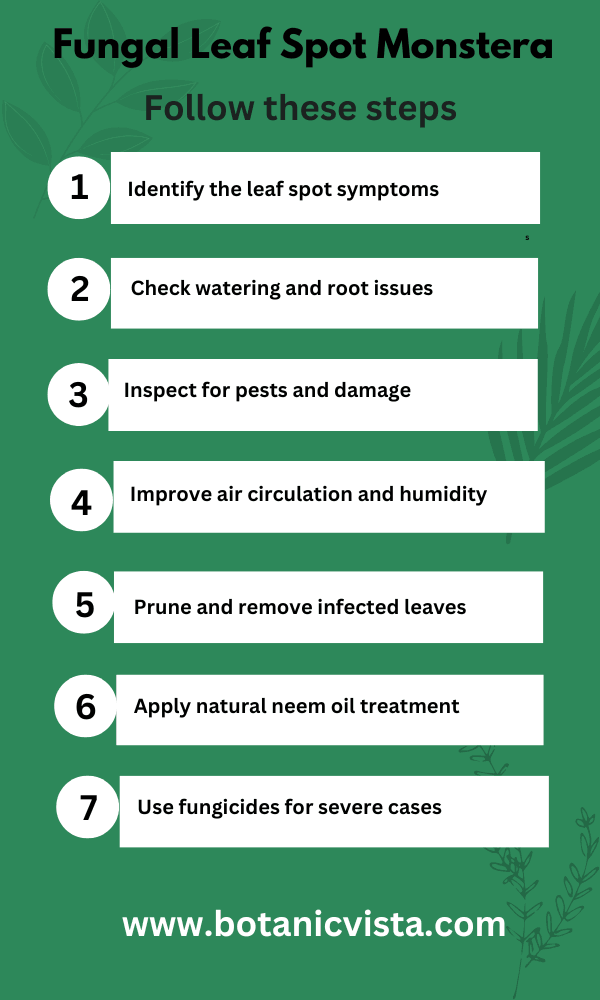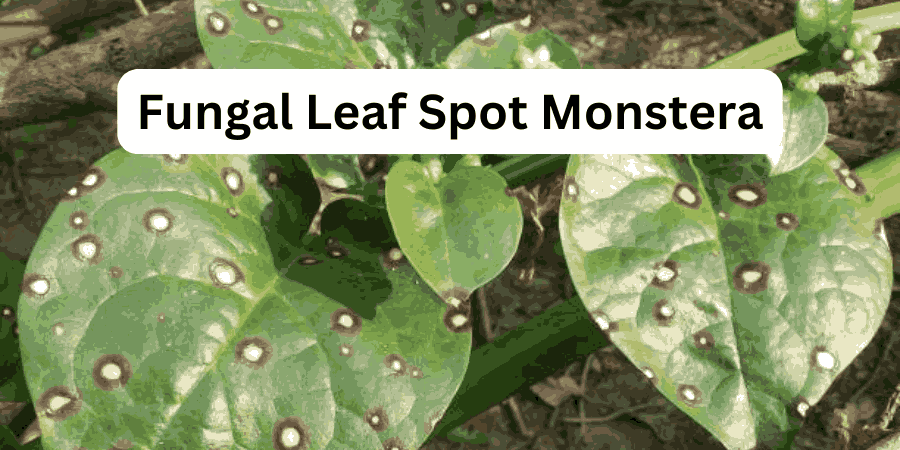Last Updated on October 18, 2024 by Jocelyn
Monstera plants are popular houseplants with big, green leaves. But sometimes, these leaves can get brown spots because of a nasty fungus. This fungus makes the leaves look bad and can stop the plant from growing well.
Fungus problems happen when there’s too much water, poor airflow, or high humidity. The rust fungus is one of the most common ones and can spread fast if not treated.
But don’t worry! With some easy gardening tips, you can help your plant stay healthy. Learning how to care for your Monstera will help keep it strong, green, and free of those nasty spots!

Table of Contents
ToggleWhat Is Fungal Leaf Spot on Monstera?
Fungal leaf spot on a Monstera is a common problem, especially in humid environments like indoor gardens. This disease shows up as raised or sunken spots on the leaves, which can be rust-colored, orange-red, or even black. If left untreated, these issues can lead to Monstera brown leaves.
Sometimes, these spots can look like powdery patches on the leaf stem or main stem, and if left untreated, the disease can spread. The fungal spores thrive in areas with poor air circulation and too much moisture. You might also notice speckling, brown spots, and spider mites, which can make the leaf look worse.
The problem worsens when pests like spider mites or poor nutrient levels contribute to leaf spot diseases. Routine inspections are important to catch alien-looking spots early. If your Monstera lives in its natural habitat, like the jungle, it might not face as many issues.
However, in indoor gardening, keeping an eye on the pH of the soil and avoiding excess fertilizer can help. Quick detection and taking the right preventative measures are key to solving this problem and maintaining healthy foliage on your beautiful Swiss cheese plant.
Symptoms of Monstera Fungal Leaf Spot
When fungal infections affect Monstera plants, you’ll notice a decline in their health and overall appearance. The leaves may start to lose their natural color, and the plant could begin to look weak.
As the issue progresses, the plant may shed leaves and experience slower growth. If not treated, the plant’s condition can worsen over time, making recovery more challenging.
Let’s explore the key symptoms so you can easily spot fungal infections in your Monstera and take prompt action.
| Symptom | Description |
| Brown spots | Dark, round spots that signal early fungal infection on the leaves. |
| Rust-colored spots | Rusty patches caused by rust fungus, indicating more severe damage. |
| Yellowing leaves | A white, flour-like substance covering the leaves, is another fungal symptom. |
| Unusual leaf drop | The plant sheds leaves excessively, weakening its structure. |
| Orange spots | Small, bright orange spots appear, indicating fungal spread. |
| Black spots | Dark black patches on leaves, signaling advanced fungal infection. |
| Halo around spots | Leaves gradually turn yellow, a sign of declining plant health. |
| Discolored leaves | Leaves display various colors, like yellow or brown, due to fungal damage. |
| Powdery mildew | Rusty patches are caused by rust fungus, indicating more severe damage. |
| Mushy roots | Roots become soft and waterlogged, often due to root rot from excess moisture. |
Causes of Leaf Spot Disease on Monstera
Monstera plants are popular for their unique leaves, but they can develop brown leaf spots due to various factors. These spots can be caused by pest infection, nutrient deficiency, or improper care like overwatering or using unsanitized tools.
Regular monitoring of the plant’s environment, including soil pH, water frequency, and air circulation, helps prevent these problems.
Below are the common causes and how to address them.
1. Watering Issues and Root Infections
Improper watering can lead to root infections, resulting in dark brown leaf spots. To prevent overwatering, check the moisture level with a moisture meter or use the finger check method. Excess moisture can cause brown patches or yellow spots on the leaves.
2. Nutrient Imbalances and Fertilizer Problems
Too much or too little fertilizer can cause nutrient burn or nutrient deficiency. Overfertilization can lead to brown edges or dark edge spots on the leaves. Using a natural fertilizer or a lime-based amendment can balance the soil’s nutrients and prevent nutrient lockout.
3. Pest Infestations and Damage
Pests like spider mites can cause leaf spots and dark specks on Monstera leaves. Always inspect the plant with a magnifying glass to catch pests early. If you find an infestation, quarantine the plant and apply a pest control solution to prevent further spot damage.
4. Poor Air Circulation and Humidity Control
Lack of air circulation can result in leaf curls and crisped edges. Ensure your plant has good ventilation and consider using a dehumidifier to control moisture levels. Placing your Monstera in a bright location also helps maintain its health.
5. Soil pH and Nutrient Absorption
Monstera plants thrive in slightly acidic conditions, and improper soil pH can affect calcium and magnesium absorption, leading to stunted growth. Testing the soil with a pH meter and adding lime-based amendments can help maintain the right soil pH for your plant’s health.
Monstera Fungus Treatment: How to Treat Fungal Leaf Spot
Fungal Leaf Spot on your Monstera can cause brown spots and brown tips. To protect your plant, it’s important to act quickly. Keep your Monstera in indirect or filtered light and make sure it’s in a ventilated room.
1. Isolating Affected Plants
If you notice fungus spread, move the infected Monstera away from other houseplants. This helps prevent the fungus spread to other healthy plants. Place it in a ventilated room to reduce future sun damage.
2. Pruning Infected Leaves
Use sterilized clippers to carefully prune below the affected area. Cut the leaves with brown spots or dry brittle edges to prevent infection. After pruning, make sure to dispose of the infected parts away from other plants.
3. Applying Fungicides
To treat plant diseases like root rot, use a clean fungicide spray. Spray on the infected spots every few days to kill fungus and save your Monstera. Always use sanitized pruning shears to prevent further infection.
4. Using Neem Oil as a Natural Remedy
For a more gentle treatment, apply neem oil to the infected leaves. Rinse off the leaves first, then spray the mixture of neem oil and water to stop the stem infection. This is a safe way to treat large areas of the plant without harming it.
5. Home Remedies for Fungal Leaf Spot
You can also try a homemade baking soda solution. Mix baking soda, water, and a bit of vinegar to create a spray. This mixture helps treat leaf spot conditions naturally and prevents root rot.
Preventing Fungal Diseases in Monstera Plants
Monstera plants are beautiful, but Fungal Leaf Spot can damage their leaves. To prevent this, taking the right care steps is key. These tips will help you keep your plant healthy and free from fungal diseases.
| Heading | Tips |
| Watering Practices | Water when topsoil is dry to avoid excess moisture. |
| Air Circulation | Ensure open space for air to prevent moisture buildup. |
| Cleaning Tools and Soil | Use sanitized tools and clean soil to prevent fungus. |
| Humidity Levels | Keep humidity moderate to avoid fungal growth |
FAQ’s
Q: How Do You Treat Fungal Leaf Spot on Monstera?
A: To treat fungal leaf spot on a Monstera, remove infected leaves using sharp scissors and sterilize them with rubbing alcohol. Then, apply an antifungal foliar spray and soil drench to target the fungus on both the leaves and soil.
Q: What Is a Homemade Fungicide for Monstera?
A: You can make a homemade fungicide by mixing 1Tbs of baking soda with a gallon of water and a few drops of dish soap. Spray the upper and lower sides of the leaves weekly for about 3 weeks. Use a 1qt sprayer to apply the solution and repeat if necessary
Q: How Do You Make Antifungal Plant Spray?
A: To make a simple antifungal spray at home, you need a gallon of water. Add four tablespoons of apple cider vinegar and one teaspoon of dish soap. Mix it well and spray it on the affected plants. This mixture is effective against fungal infections.
Q: How Do You Get Rid of Leaf Spot Disease?
A: To get rid of leaf spot disease, first remove any infested leaves or branches. Avoid overhead watering and ensure the plant has good airflow. Keep the area around the plant dry to prevent the disease from spreading further.
Q: When Should You Not Use Neem Oil?
A: You should avoid using neem oil on young or tender leaves. It may burn new growth if you apply it during the morning or evening when the oil is less likely to dry quickly. Transplants and early growth can be harmed by this pesticide if used at the wrong times.
Conclusion
Fungal leaf spots appear as brown or black patches on leaves. This is often caused by overwatering and high humidity. To control it, remove affected leaves and increase airflow around the plant. Always clean your tools after pruning to prevent spreading.
Water your Monstera less frequently, allowing the soil to dry between waterings. Use a houseplant-safe fungicide if needed. Early detection and care can help your plant recover.
Try these tips to manage fungal leaf spots and keep your Monstera healthy!

